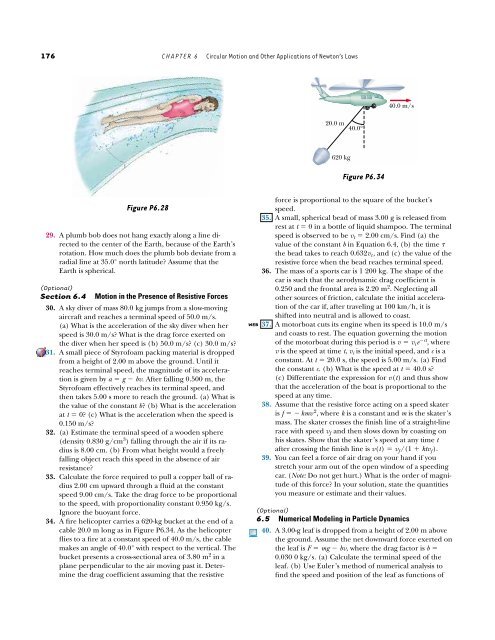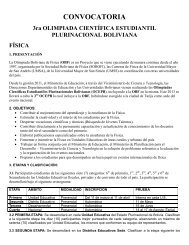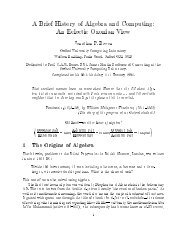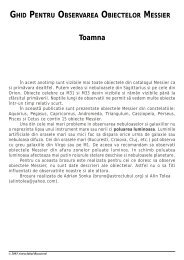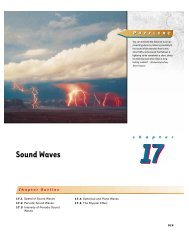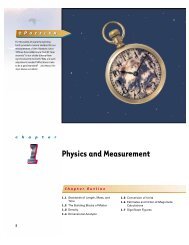Circular Motion and Other Applications of Newton's Laws
Circular Motion and Other Applications of Newton's Laws
Circular Motion and Other Applications of Newton's Laws
Create successful ePaper yourself
Turn your PDF publications into a flip-book with our unique Google optimized e-Paper software.
176 CHAPTER 6 <strong>Circular</strong> <strong>Motion</strong> <strong>and</strong> <strong>Other</strong> <strong>Applications</strong> <strong>of</strong> Newton’s <strong>Laws</strong><br />
Figure P6.28<br />
29. A plumb bob does not hang exactly along a line directed<br />
to the center <strong>of</strong> the Earth, because <strong>of</strong> the Earth’s<br />
rotation. How much does the plumb bob deviate from a<br />
radial line at 35.0° north latitude? Assume that the<br />
Earth is spherical.<br />
(Optional)<br />
Section 6.4 <strong>Motion</strong> in the Presence <strong>of</strong> Resistive Forces<br />
30. A sky diver <strong>of</strong> mass 80.0 kg jumps from a slow-moving<br />
aircraft <strong>and</strong> reaches a terminal speed <strong>of</strong> 50.0 m/s.<br />
(a) What is the acceleration <strong>of</strong> the sky diver when her<br />
speed is 30.0 m/s? What is the drag force exerted on<br />
the diver when her speed is (b) 50.0 m/s? (c) 30.0 m/s?<br />
31. A small piece <strong>of</strong> Styr<strong>of</strong>oam packing material is dropped<br />
from a height <strong>of</strong> 2.00 m above the ground. Until it<br />
reaches terminal speed, the magnitude <strong>of</strong> its acceleration<br />
is given by a � g � bv. After falling 0.500 m, the<br />
Styr<strong>of</strong>oam effectively reaches its terminal speed, <strong>and</strong><br />
then takes 5.00 s more to reach the ground. (a) What is<br />
the value <strong>of</strong> the constant b? (b) What is the acceleration<br />
at t � 0? (c) What is the acceleration when the speed is<br />
0.150 m/s?<br />
32. (a) Estimate the terminal speed <strong>of</strong> a wooden sphere<br />
(density 0.830 g/cm3 ) falling through the air if its radius<br />
is 8.00 cm. (b) From what height would a freely<br />
falling object reach this speed in the absence <strong>of</strong> air<br />
resistance?<br />
33. Calculate the force required to pull a copper ball <strong>of</strong> radius<br />
2.00 cm upward through a fluid at the constant<br />
speed 9.00 cm/s. Take the drag force to be proportional<br />
to the speed, with proportionality constant 0.950 kg/s.<br />
Ignore the buoyant force.<br />
34. A fire helicopter carries a 620-kg bucket at the end <strong>of</strong> a<br />
cable 20.0 m long as in Figure P6.34. As the helicopter<br />
flies to a fire at a constant speed <strong>of</strong> 40.0 m/s, the cable<br />
makes an angle <strong>of</strong> 40.0° with respect to the vertical. The<br />
bucket presents a cross-sectional area <strong>of</strong> 3.80 m2 in a<br />
plane perpendicular to the air moving past it. Determine<br />
the drag coefficient assuming that the resistive<br />
WEB<br />
20.0 m<br />
620 kg<br />
40.0°<br />
Figure P6.34<br />
40.0 m/s<br />
force is proportional to the square <strong>of</strong> the bucket’s<br />
speed.<br />
35. A small, spherical bead <strong>of</strong> mass 3.00 g is released from<br />
rest at t � 0 in a bottle <strong>of</strong> liquid shampoo. The terminal<br />
speed is observed to be v t � 2.00 cm/s. Find (a) the<br />
value <strong>of</strong> the constant b in Equation 6.4, (b) the time �<br />
the bead takes to reach 0.632v t, <strong>and</strong> (c) the value <strong>of</strong> the<br />
resistive force when the bead reaches terminal speed.<br />
36. The mass <strong>of</strong> a sports car is 1 200 kg. The shape <strong>of</strong> the<br />
car is such that the aerodynamic drag coefficient is<br />
0.250 <strong>and</strong> the frontal area is 2.20 m 2 . Neglecting all<br />
other sources <strong>of</strong> friction, calculate the initial acceleration<br />
<strong>of</strong> the car if, after traveling at 100 km/h, it is<br />
shifted into neutral <strong>and</strong> is allowed to coast.<br />
37. A motorboat cuts its engine when its speed is 10.0 m/s<br />
<strong>and</strong> coasts to rest. The equation governing the motion<br />
<strong>of</strong> the motorboat during this period is v � v ie �ct , where<br />
v is the speed at time t, v i is the initial speed, <strong>and</strong> c is a<br />
constant. At t � 20.0 s, the speed is 5.00 m/s. (a) Find<br />
the constant c. (b) What is the speed at t � 40.0 s?<br />
(c) Differentiate the expression for v(t) <strong>and</strong> thus show<br />
that the acceleration <strong>of</strong> the boat is proportional to the<br />
speed at any time.<br />
38. Assume that the resistive force acting on a speed skater<br />
is f ��kmv 2 , where k is a constant <strong>and</strong> m is the skater’s<br />
mass. The skater crosses the finish line <strong>of</strong> a straight-line<br />
race with speed v f <strong>and</strong> then slows down by coasting on<br />
his skates. Show that the skater’s speed at any time t<br />
after crossing the finish line is v(t) � v f/(1 � ktv f).<br />
39. You can feel a force <strong>of</strong> air drag on your h<strong>and</strong> if you<br />
stretch your arm out <strong>of</strong> the open window <strong>of</strong> a speeding<br />
car. (Note: Do not get hurt.) What is the order <strong>of</strong> magnitude<br />
<strong>of</strong> this force? In your solution, state the quantities<br />
you measure or estimate <strong>and</strong> their values.<br />
(Optional)<br />
6.5 Numerical Modeling in Particle Dynamics<br />
40. A 3.00-g leaf is dropped from a height <strong>of</strong> 2.00 m above<br />
the ground. Assume the net downward force exerted on<br />
the leaf is F � mg � bv, where the drag factor is b �<br />
0.030 0 kg/s. (a) Calculate the terminal speed <strong>of</strong> the<br />
leaf. (b) Use Euler’s method <strong>of</strong> numerical analysis to<br />
find the speed <strong>and</strong> position <strong>of</strong> the leaf as functions <strong>of</strong>


